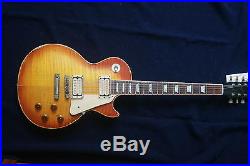

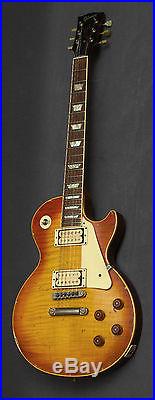
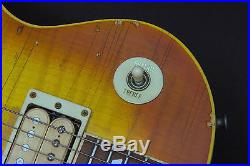
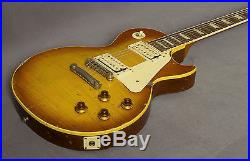
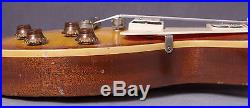
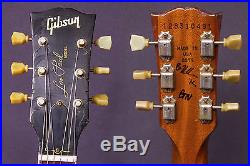
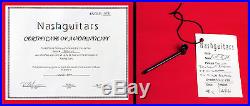
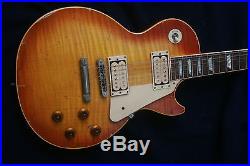
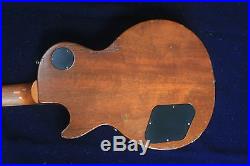
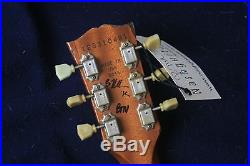
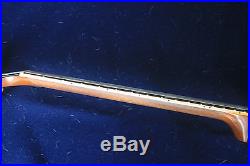

This guitar plays like a dream and the DiMarzio pickups sound fantastic. This guitar really is a rocker’s dream, come true! The Tangerine Burst color, which is rarer to find than the more common cherry burst color, is off the charts and really sets this guitar apart from other Nash aged Gibson Les Pauls. The guitar has maybe three hours of playing time on it total. The Gibson Les Paul case that the guitar came in is in new condition and the original Nash Certificate of Authenticity is also included as well as the original hang tag from Nash describing the guitar, pickups used, etc. Here is more information from the owner. This guitar is a real Gibson Les Paul made in 2011 by Gibson that was sent to Nash for rebuilding and aging in 2012……….. Out of all the Les Paul models and guitars made, this guitar was picked as a premium example to be rebuilt by Nash…… The serial can be looked up to verify this and it can also be confirmed by Gibson. Nash only chooses a few of all the Les Pauls out there that are the best candidates for rebuilding to their high standards………….. These Nash Gibson Les Paul rebuilds are considered to be the best playing, smoothest, easiest playing, with best action Les Pauls that have ever been made and are available on the market (even Gibson custom shop Les Pauls don’t begin to compare to the playability and quality of Nash’s rebuild of these Les Pauls and the added higher-quality parts Nash puts in them). This guitar is not chambered. Included below is a description of the Gibson Les Pauls Bill Nash takes for rebuild and the process he goes through to rebuild them (taken from SoundPure’s write-up on Nash’s rebuilding process): Description. These are real Gibson Les Paul Standard guitars [that I have sent to me (Bill Nash) from authorized Nash Dealers] for a complete make over. There are a few models that make good candidates for this, depending on the final color (plain, flame or gold top). The faded standards, the classic standards and classic plus standards are all possibilities as a starting piece. First step is to completely disassemble and separate the parts that will be aged and re-used, from the parts that we reject and replace. The keeper parts are then aged. The finish, which is sometimes rather thick, is stripped off down to the bare wood. At this point some get stains applied, if required to get the desired color. Then the guitar gets re-finished in 100% nitrocellulose lacquer, keeping it as thin as possible to enable superior resonance. We do a variety of takes on the lemon, cherry, faded, un-burst, plain and gold top looks. After curing, the guitar gets the complete aging treatment and is then frets are re-worked and dressed to our specs, then we are ready for re-assembly. The pickups are replaced with what many of you may balk at as there are so many opinions about Les Paul pickups and tone out there. As always, I simply build a guitar that I would use and leave it at that. So, in my arsenal of personal guitars, my favorite and most versatile LP setup is using a DiMarzio Bluesbucker in the Neck and a DiMarzio Air Norton in the Bridge. Between 1 and 8 on the tone knob it works as a regular tone control, between 9 and 10 it shuts off the second/dummy coil. This gives you a tap without adding switches of push pull pots. The Air Norton give you bigger output and rich harmonics without going over the top into the tone spectrum of faceless, modern, high output sound that so many specialized humbuckers are susceptible to. These pickups have a lower string pull and a much higher sensitivity to your dynamics and playing style. My problem with stock Les Pauls is that the pickups never seem truly matched to each other or the position that they inhabit. The bridge will often sound harsh or weak. The middle position (both pickups together) has an incredible potential for sparkle and quack, but no stock Les Paul, I have had, other than an actual 59 burst had this. Does this sound familiar? Also, as many of you may have figured out, the method Gibson uses for wiring the pots is not optimum. The tendency towards the guitar getting muddy or sounding choked when anywhere but 10. This gets re-worked when we re-wire. Gibson installs frets on the fretboard prior to it getting glued to the neck and body. Maybe they do it as it is easier to do it that way, but it can really lead to all sort of fret issues (buzzing, fret outs, high action, dead spots etc). What happens is the neck and body glue, moisture, and all of the underlying structure will shrink, expand and or settle. The fretboard (and frets) will now adjust itself to the changes and you and up with lumpy gravy. The most noticeable and common issue is the hump at about the 14th fret, right where the neck gets really thick before it hits the body. So what we do is now re-work the neck and frets and take care of this to give the player better action, playability, sustain, bending etc. 088 – note that this guitar has excellent fret work and great playability and action…… That’s why I (the owner of the guitar) originally bought it……. This is the best playing Les Paul I’ve ever had or played (and I’ve played a ton of them)….. You won’t find a better one. Also the following quote is from SoundPure’s original write-up on the guitar……. We’ve had a handful of aged LP’s with the cream pickups and they continue to be a great modified look for particular finishes. It looks especially rockin’ on this tangerine burst LP! Super slick fretwork on this axe! The flame top really pops in certain light. It’s a stage guitar. You won’t want to hide this away in the studio, although, you will want to record with it. Lower 48 ONLY> THanks. The item “2012 Nash NGLP 60’s Les Paul Conversion Electric Guitar! Tang Burst 88″ is in sale since Sunday, February 07, 2016. This item is in the category “Musical Instruments & Gear\Guitars & Basses\Electric”. The seller is “n3ss” and is located in Moorestown, New Jersey. This item can be shipped to United States.
- Brand: Gibson
- MPN: Does Not Apply
- Model: Les Paul 1960
